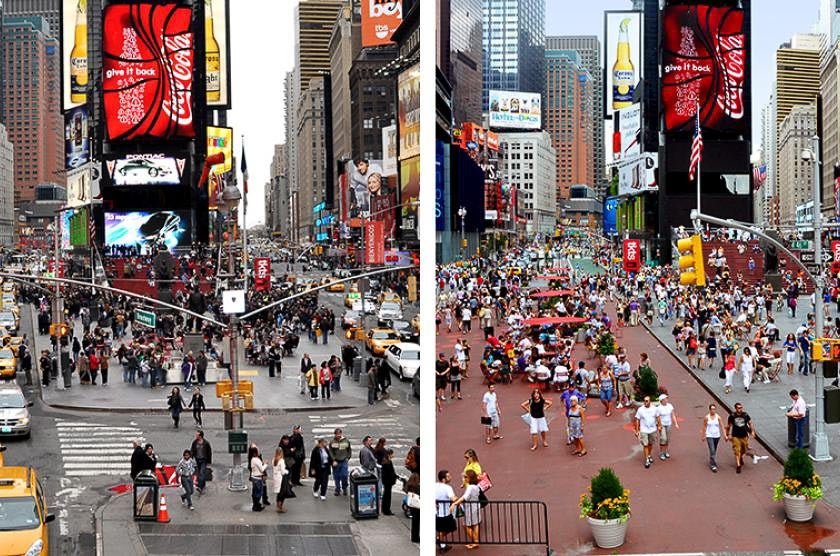A new Kinder Institute report highlights several approaches that area stakeholders might consider in their efforts to improve the built environment and infrastructure around the Rice Village.
The retail and restaurant area, just west of the Rice University campus in Houston, is a popular destination but is fraught for pedestrians and people who ride on bicycles: crosswalks aren’t respected, bike lanes are non-existent, and sidewalks are narrow.
Here are four examples from around Houston and across the United States that Rice Village could learn from.
And, don’t worry. They only slightly touch on parking.
1. Create Pedestrian Spaces
During Michael Bloomberg’s tenure as mayor of New York City, the city used temporary measures to transform Times Square from a car-centric space to one that made pedestrian and bicycle travel a greater priority. The provisional, piecemeal approach allowed the city to observe the way people used the space and document how traffic shifted. After finding mostly positive outcomes the plazas were made permanent.
In Los Angeles, a short, awkward section of roadway was transformed into a pedestrian space that allowed for several uses. Based on the Times Square model, the plaza began as temporary, but discussions about making it permanent are ongoing.
Rice Village could consider a slate of temporary, test case transformations such as participating in a Sunday Streets event, holding a movie night or festival in area parking lots, or even closing a section of a secondary road in order to install a temporary plaza. The power of these social spaces is made abundantly clear by the popularity of Discovery Green and the green space at Houston’s CityCentre development.
2. Install Parklets
The Rice Village area is awash in on-street parking but lacks any meaningful gathering or resting spaces. In recent years parklets have become an answer to just this problem. By converting on-street parking spots into public spaces or for use as additional outdoor seating for businesses, commercial districts can encourage shoppers to linger. These spaces can also provide an interesting urban canvas for the work of local artists, designers, and architects in their creation. Like the implementation of pedestrian plazas, parklets could begin as temporary spaces.
There are several innovative and attractive examples across the country. And Houston even has an existing parklet in the Heights.
3. Look to Babgy’s “Complete Streets”
Houston has a complete streets executive order (still waiting on an ordinance) that requires the public works and planning departments to consider all users of the public right-of-way – not just cars – when planning street reconstruction. While projects have been slow to develop, a complete street effort spearheaded by a local management districts offer Rice Village good models for approaching potential changes to thoroughfares such as University and Rice Boulevards.
By narrowing a busy thoroughfare and adding pedestrian facilities, the Bagby Street reconstruction in midtown Houston reduced traffic speeds and created a still well functioning (but less car-centric) street. Additional landscaping added much-needed shade and resting spots for pedestrians. The more pedestrian friendly environment has been a boon to local commercial districts and mixed-use developments.
Rice Village has a lot of options to diversify its street use. Adding bike lanes, benches, shrinking traffic lanes, or widening sidewalks would all be viable options.
4. Decorate Crosswalks
Every year communities in Portland, Oregon are given a chance to decorate intersections any way they see fit. The results are not just an impressive collection of localized art but also an intriguing way to make shared space. Meanwhile, drivers are more likely to pay attention to other users of an intersection when the shared spaces are demarcated in interesting ways.
While Portland paints the whole intersection, other places, including Houston, have used paint to turn regular crosswalks in places with lots of foot traffic into more visible – and thus safer – spaces.
Midtown Houston recently installed a colorful matrix at the intersection of Elgin and Louisiana Streets.
And the museum district has had a decorated crosswalk for years (though it could use a touchup.)
Rice Village is a pedestrian-scaled commercial district built for cars. Only rarely are pedestrians deferred to in crosswalks. And at almost any corner an observer can watch cars come to a stop well past the stop lines and often in the path of pedestrians.
Better demarcating crosswalks could help prevent this issue and add some needed color to the district.
Those are just four options we reference in our new report on Rice Village. But of course, these options aren’t limited to that neighborhood, or even Houston.
Any district where pedestrians have more difficulty than they should can implement these solutions as they strive to make incremental steps in the right direction.

